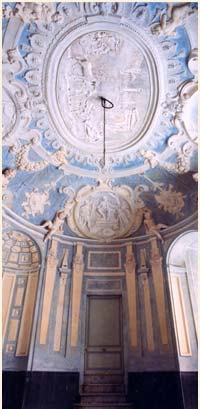Beyond the large main door, it opens up an oval-shaped atrium, whose short sides house four small lacunar exhedrae. Between one exhedra and the other, there are pairs of Ionic herms, alternated with panels surmounted by a small obelisk.
A precious ceiling with fanciful stucco decorations features a medallion at the centre, representing a warlike feat of bravery according to the most ancient and reputed iconography, whereas the globes placed around it represent different views of the subject of the imperator and his liberality, after Müller Profumo's interpretation.
An imaginary fabric hangs around the central oval and connects the various medaillons with elegant swirls, vegetal swags, weapon trophies, small putti.
Stucco decorations are Sparzo's handworks, but the design of this room and the décor are likely to be ascribed again to the genius of "Il Bergamasco", whose style is manifest in the bizarre typology of the herms, peculiar of the mannerist style of this artist.
Prior to the last restoration works, the atrium was dulled by an ochre-greenish colour painting which did not help a clean-cut interpretation of the various elements; today the cleaning of the surfaces and some restoration works gave back the stucco decorations their original white and light-blue shades. Beyond the atrium, we pass through a hallway - whose lunettes, recently restored, disclose naval and marine figures, which most likely date back to the seventeenth century - into a vast courtyard, closed at the end by a majestic nymphaeum.

The cleaning of the surfaces and the different restoration works gave back the stucco decorations their original white and light-blue shades.
